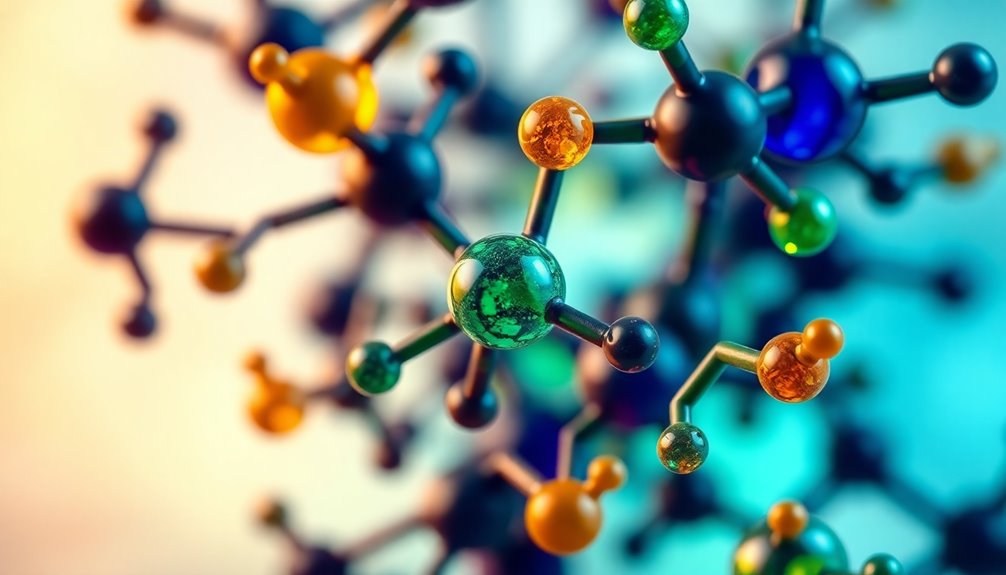Yes, aromatic amino acids are generally hydrophobic. Amino acids like Phenylalanine and Tryptophan have large, nonpolar side chains that repel water. This hydrophobic nature helps them cluster together within the protein's core, enhancing stability. While Tyrosine has a hydroxyl group that gives it some hydrophilic traits, it remains largely hydrophobic overall. Overall, these amino acids play significant roles in protein structure and function. Their unique characteristics make them important for various biochemical processes. If you're curious about their specific functions or how they interact in proteins, you might find more insights ahead.
Key Takeaways
- Aromatic amino acids include Phenylalanine, Tyrosine, and Tryptophan, with differing hydrophobic properties.
- Phenylalanine and Tryptophan are primarily hydrophobic due to their large nonpolar side chains.
- Tyrosine is less hydrophobic because of its -OH group, though it remains largely hydrophobic overall.
- The hydropathy index indicates Phenylalanine (~100) and Tryptophan (~70) as hydrophobic amino acids.
- Aromatic amino acids cluster in protein interiors, minimizing water contact and enhancing protein stability through hydrophobic interactions.
Overview of Aromatic Amino Acids
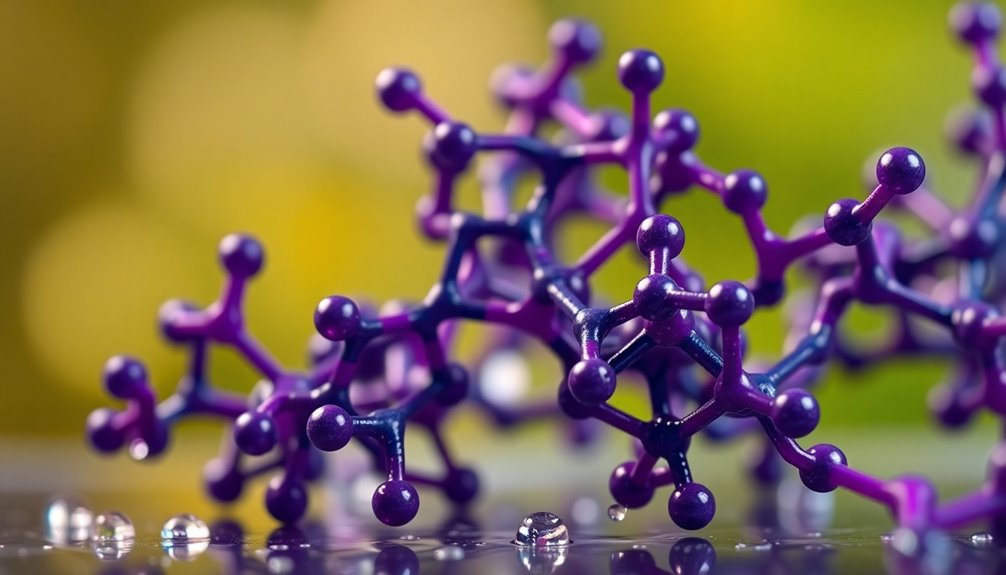
Aromatic amino acids are essential building blocks of proteins, distinguished by their unique aromatic side chains. Key examples include Phenylalanine (Phe), Tyrosine (Tyr), and Tryptophan (Trp).
Phe and Trp are generally considered hydrophobic amino acids due to their large, nonpolar aromatic rings. In contrast, Tyr, which has a hydroxyl (-OH) group, exhibits more hydrophilic characteristics. The hydropathy index highlights this distinction, with Phe scoring around 100 and Trp around 70.
These aromatic amino acids play vital roles in protein structure and stability, contributing considerably to the hydrophobic core, especially in enzymes and membrane proteins. Additionally, their aromatic rings allow them to absorb ultraviolet light, aiding in protein quantification and analysis.
Hydrophobicity and Polarity Explained
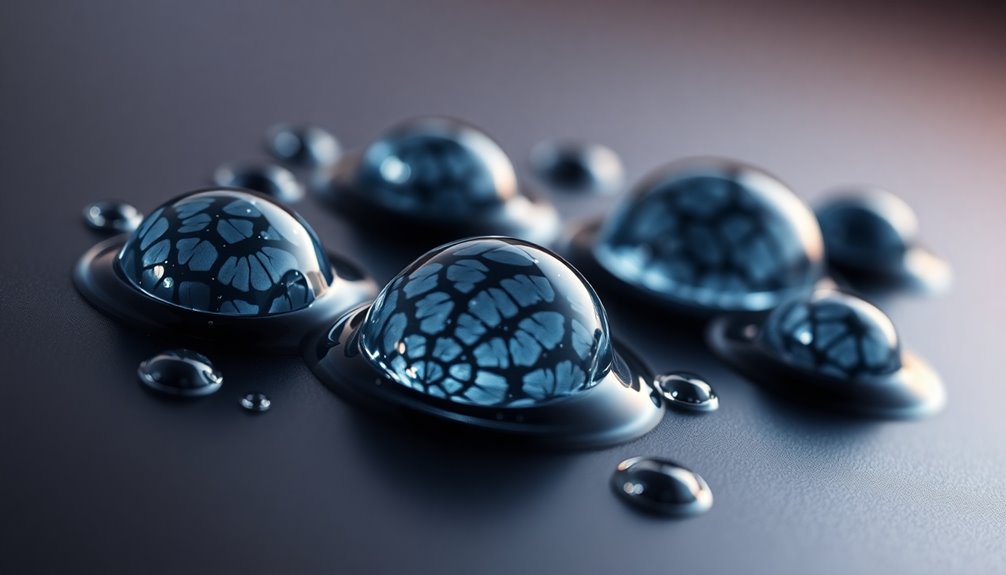
Understanding hydrophobicity and polarity is essential when exploring how amino acids interact within proteins.
Aromatic amino acids like Phenylalanine, Tryptophan, and Tyrosine are generally hydrophobic due to their large, nonpolar aromatic side chains that avoid water.
Even though Tyrosine has a polar hydroxyl group, its aromatic nature still classifies it as hydrophobic overall.
The hydrophobicity index shows that these amino acids possess high values, indicating their tendency to cluster in the hydrophobic core of protein structures, away from aqueous environments.
This clustering enhances protein stability through hydrophobic interactions and contributes to van der Waals forces.
Structural Characteristics of Aromatic Amino Acids
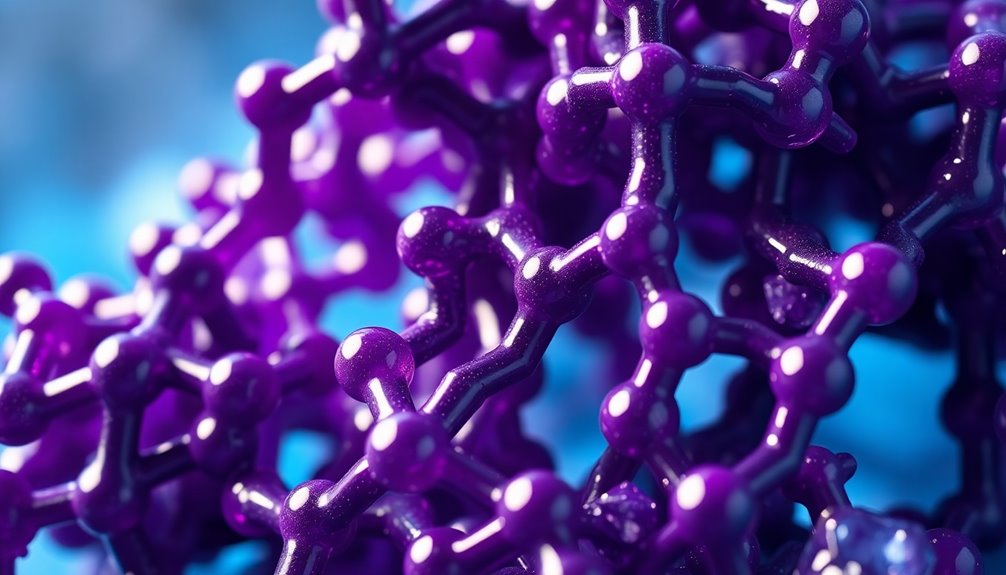
While exploring the structural characteristics of aromatic amino acids, you'll find that their unique aromatic rings play an essential role in defining their properties. These rings contribute to the hydrophobicity of amino acids like Phenylalanine, Tyrosine, and Tryptophan, allowing them to avoid interactions with water.
| Amino Acid | Key Structural Feature | Hydrophobicity |
|---|---|---|
| Phenylalanine | Benzene ring | Highly hydrophobic |
| Tyrosine | Hydroxyl group | Mainly hydrophobic |
| Tryptophan | Indole side chain | Moderately hydrophobic |
Despite Tyrosine's ability to form hydrogen bonds due to its hydroxyl group, its overall structure remains mainly hydrophobic, contributing to protein stability through hydrophobic interactions.
Role in Protein Function
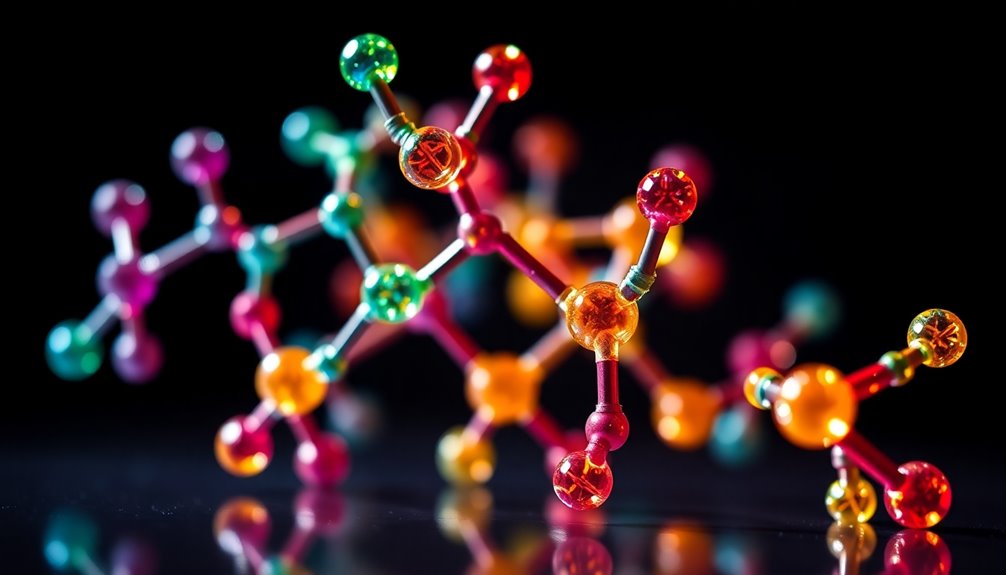
The hydrophobic characteristics of aromatic amino acids greatly influence their role in protein function. These amino acids, like Phenylalanine, Tyrosine, and Tryptophan, have nonpolar aromatic side chains that cause them to cluster away from water, stabilizing protein folding through van der Waals interactions in the hydrophobic core.
Tryptophan, despite its nitrogen atom, remains hydrophobic and often contributes to binding sites, enhancing protein interactions.
Tyrosine's hydroxyl group adds versatility, allowing it to form hydrogen bonds while maintaining its hydrophobic nature. This duality means aromatic amino acids frequently appear in active sites and interfaces, where their hydrophobicity plays a significant role in substrate binding and specificity, ultimately impacting overall protein function.
Comparison With Other Amino Acids
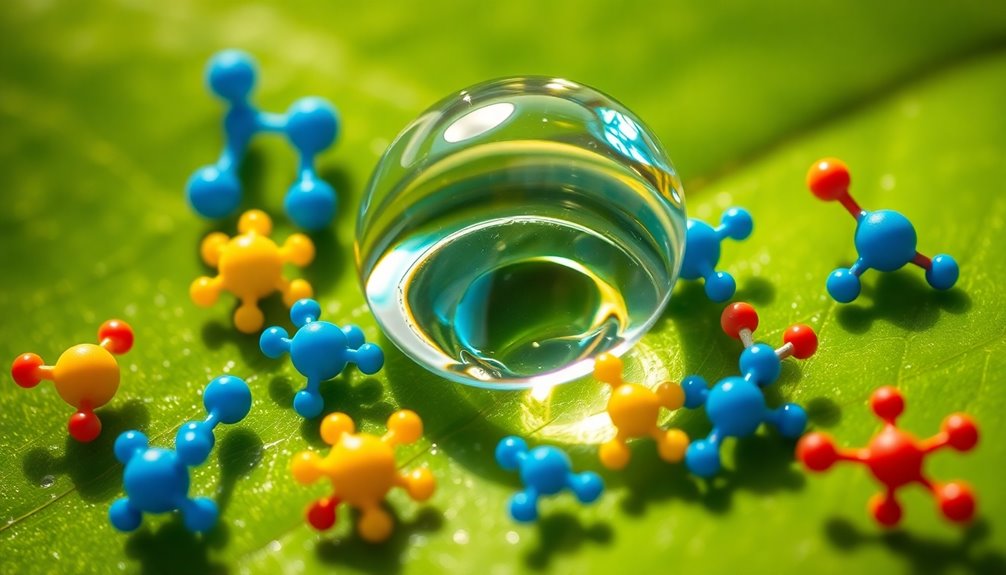
When you compare aromatic amino acids to others, you'll notice their unique side chains set them apart.
While phenylalanine and tryptophan are more hydrophobic, tyrosine's polar -OH group gives it a different character.
This distinction plays a vital role in how proteins fold and function, highlighting the balance between hydrophobicity and polarity in amino acid interactions.
Aromatic Side Chain Characteristics
Aromatic amino acids, such as phenylalanine, tyrosine, and tryptophan, stand out from other amino acids due to their distinctive hydrophobic side chains. Their unique structure and hydrophobic characteristics enable specific interactions that contribute to protein stability.
Here are key features to evaluate:
- Nonpolar Nature: Aromatic side chains are largely nonpolar, repelling water and promoting hydrophobic interactions.
- π-π Stacking: These side chains can stack together, enhancing stability in protein structures.
- Interior Positioning: Unlike polar amino acids, aromatic amino acids are often found buried in the hydrophobic core of proteins.
- Hydroxyl Group in Tyrosine: Tyrosine's hydroxyl group adds slight polarity, but its overall hydrophobic nature prevails.
Understanding these characteristics helps appreciate the role of aromatic amino acids in protein folding.
Hydrophobicity Versus Polarity
While many amino acids possess unique properties, the contrast between hydrophobicity and polarity in aromatic amino acids like phenylalanine, tyrosine, and tryptophan highlights their distinct roles in protein structure.
Phenylalanine, the most hydrophobic of the group, features a nonpolar aromatic side chain that avoids aqueous environments. In comparison, tyrosine contains a hydroxyl group, making it less hydrophobic and more polar, allowing it to interact with water.
Tryptophan sits between the two, showcasing both hydrophobicity and some polar character due to its nitrogen-containing indole side chain. This balance influences how these amino acids behave in proteins, affecting folding, stability, and interactions.
Understanding their hydrophobicity and polar characteristics is essential for grasping their functional significance.
Role in Protein Structure
The role of aromatic amino acids in protein structure is essential, especially when compared to other types of amino acids. These amino acids considerably contribute to forming the hydrophobic core of proteins, enhancing stability and function.
Here's how they compare:
- Hydrophobic Nature: Aromatic amino acids like Phenylalanine cluster in the protein interior, avoiding water.
- Polar Interactions: Tyrosine and Tryptophan can engage in polar interactions due to their unique side chains.
- Stabilization: They promote protein folding through π-π stacking and hydrophobic effects.
- Spectroscopic Utility: Their ability to absorb UV light aids in studying protein concentrations.
Understanding these factors highlights the distinct role aromatic amino acids play in creating a stable hydrophobic core, differentiating them from aliphatic and polar amino acids.
Influence of Environmental Factors

Environmental factors play an essential role in shaping the behavior of aromatic amino acids like phenylalanine, tyrosine, and tryptophan.
While you might see these amino acids as generally hydrophobic due to their large, nonpolar aromatic side chains, their hydrophobicity can shift based on their surroundings. For instance, changes in pH and ionic strength can modify the ionization states of these amino acids, altering their interactions within proteins.
In aqueous environments, they typically cluster in the protein's interior to minimize water contact. However, the presence of hydroxyl or amino groups, particularly in tyrosine and tryptophan, enables some hydrogen bonding, slightly enhancing their compatibility with polar environments.
Consequently, environmental factors significantly influence their behavior and interactions.
Applications in Biochemistry and Medicine

Aromatic amino acids play an essential role in biochemistry and medicine, influencing a wide array of biological processes. Their hydrophobic characteristics and unique amino acids side chains contribute greatly to various functions, including:
- Precursor Role: They're precursors for vital biomolecules like serotonin and thyroxine.
- Protein Stability: Their hydrophobic nature aids in stacking interactions, enhancing protein folding and stability.
- Metabolic Indicators: Levels of these amino acids can signal metabolic disorders, such as phenylketonuria (PKU).
- Drug Design: Their properties make them valuable in drug development, increasing binding affinity through π-π interactions.
Frequently Asked Questions
Is Aromatic Hydrophilic or Hydrophobic?
When you consider whether something is hydrophilic or hydrophobic, think about its interaction with water.
Aromatic compounds generally lean towards hydrophobic due to their nonpolar nature. However, some, like tyrosine, have polar groups that allow them to interact with water.
So, while most aromatic compounds avoid water, they can exhibit some hydrophilic qualities depending on their specific structure and functional groups.
It's crucial to analyze each case individually.
Are Aromatic Amino Acids Nonpolar?
When you consider if aromatic amino acids are nonpolar, you'll find that they generally are. Their side chains, like those in phenylalanine, tryptophan, and tyrosine, possess nonpolar characteristics, which contribute to their overall hydrophobic nature.
Even though tyrosine has a polar hydroxyl group, its aromatic structure still leans towards nonpolarity. This nonpolar behavior is essential for stabilizing protein structures and influencing their interactions within biological systems.
What Amino Acids Are Hydrophobic?
When you think about hydrophobic amino acids, you'll find several key players.
Leucine, isoleucine, valine, and methionine all fall into this category, along with phenylalanine, tryptophan, and tyrosine.
These amino acids have nonpolar side chains that repel water, which helps them stabilize proteins by forming a hydrophobic core.
In proteins, they often hide away from the aqueous environment, enhancing overall structure and function.
Is TRP Hydrophobic or Hydrophilic?
Imagine a ship sailing smoothly through a sea of oil—that's tryptophan for you.
It's largely hydrophobic, thanks to its bulky aromatic indole side chain that shies away from water.
However, don't be fooled by its aversion to water; it's not entirely aloof. With a nitrogen atom ready to form hydrogen bonds, it straddles both worlds, making it a unique player in protein structures and interactions.
Conclusion
In conclusion, while aromatic amino acids are often considered hydrophobic due to their bulky, ring-like structures, they also display polar characteristics that can influence their behavior in proteins. Think of them as the chameleons of the amino acid world, adapting to their surroundings. Understanding their unique properties is essential for grasping protein function and interactions. So, whether you're delving into biochemistry or medicine, keep an eye on these versatile players in the molecular game.

